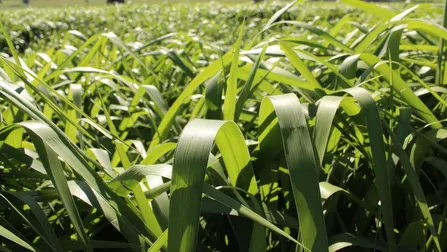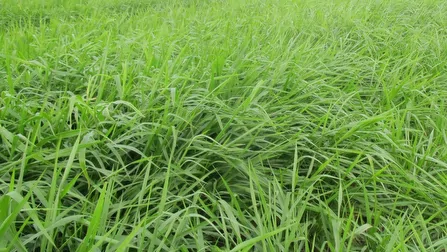O Departamento de Pesquisa e Desenvolvimento do Grupo Matsuda é o primeiro do Brasil, com investimento privado no setor de gramíneas e leguminosas forrageiras. O resultado da dedicação e comprometimento da empresa, pesquisadores, parceiros e colaboradores, foi o lançamento de diversos materiais amplamente conhecidos e utilizados com sucesso por todo o país, tais como o MG18 Áries II (2020), MG12 Paredão (2015), MG5 Vitória (2000) e outros.

MG19 Oásis 2024
A Cultivar MG19 Oásis possui uma boa produção de forragem, boa qualidade nutricional e maciez da forragem produzida, sendo recomendada para produção de leite e carne, nas fases de cria, recria e engorda. É indicado para solos de média a alta fertilidade, no sistema intensivo de pastejo rotacionado com intervalos de descanso de 25 dias no período chuvoso.

MG18 Áries II 2020
Devido a sua excelente qualidade nutricional, palatabilidade e porte médio, possui uma ampla aptidão para diversas categorias e espécies animais, sendo recomendada para todas as fases da produção de leite e carne, além de equinos, caprinos e ovinos.

MG11 Tijúca 2016
É indicada para solos mal drenados e de média a baixa fertilidade, sendo assim uma boa opção para substituir a Humidicola nestas áreas. Comparada a Humidícola, possui a vantagem de apresentar melhor qualidade nutricional e as sementes não apresentarem dormência.

MG7 Tupã 2016
É uma forrageira indicada para solos de média a baixa fertilidade, poucos profundos e também com cascalho. É uma ótima opção para regiões mais secas.

MG12 Paredão 2015
O Paredão se destaca pela excelente produção de forragem e sua qualidade nutricional, sendo recomendada para a produção de leite e carne, nas fases de cria, recria e engorda. É indicado para solos de alta fertilidade, corrigidos e adubados, no sistema intensivo de pastejo rotacionado com intervalos de descanso de 25-28 dias. Pode ser utilizado também para ensilagem.

MG13 Braúna 2015
A Braúna é indicada para solos de média a alta fertilidade. O crescimento mais prostrado de sua touceira (decumbente), seus talos mais finos e boa rebrota, facilitam o manejo desta gramínea, além do bom fechamento do solo.

Atlas 2003
Indicada para solos de alta fertilidade. Pela boa tolerância ao alumínio do solo, possui bom desenvolvimento do seu sistema radicular conferindo a cultivar uma ótima rebrota e boa adaptação na seca.

Java 2003
É uma leguminosa indicadas a solos de baixa fertilidade. Tem boa adaptação/simbiose aos diversos tipos de Rhizobium do solo, portanto elevada absorção de nitrogênio atmosférico, e quando ingerida pelos bovinos fornece uma alimento de excelente qualidade nutricional (18 a 23% PB).

MG-5 Vitória 2000
É uma Braquiária com excelente potencial de produção de forragem (até 18 t/ha/ano de M.S.). É indicada pras solos de média a alta fertilidade. Possui tolerância a solos mal-drenados ou alagamentos de períodos curtos.

Capim Elefante Paraiso 1999
É o primeiro híbrido de capim elefante propagado por sementes. Cultivar com alto potencial de produção de forragem (até 50 t/ha/ano de M.S.). Indicado para solos de alta fertilidade, corrigidos e adubados.

Arachis pintoi cv. Amarillo MG100 1995
O amendoim forrageiro é indicado em consorcio com forrageiras de porte baixo. Possui boa palatabilidade e qualidade nutricional (15 a 22% PB).

MG 4 1994
Indicada para solos de média fertilidade para bovinos de cria, recria e engorda e leite. Pode ser utilizada para pastejo direto e fenação.

Dictyoneura (Llanero) 1992
Indicado para solos de média a baixa fertilidade, arenosos, com acidez e excesso de umidade.